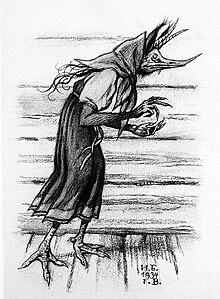Kikimora

Kikimora (Russian: кики́мора, IPA: [kʲɪˈkʲimərə]) is a legendary creature, a female house spirit in Slavic (especially Eastern) mythology. Her role in the house is usually juxtaposed with that of the domovoy, whereas one of them is considered a "bad" spirit, and the other, a "good" one. When the kikimora inhabits a house, she lives behind the stove or in the cellar, and usually produces noises similar to those made by the mice in order to obtain food. Kikimory (in plural) were the first traditional explanation for sleep paralysis in the Russian folklore.
The word kikimora may have derived from Udmurt (Finn-Ugric) word kikka-murt (compare Finnish Kikke Mörkö), meaning scarecrow (literally bag-made person), although other etymological hypotheses also exist. The OED links mora with the mare of nightmare, moreover, inconclusive linguistic evidence suggests that the French word cauchemar might have also derived from the same root.[1]
There are two different kinds of Kikimoras. The one that comes from the forest is married to the Domovoi. The other one comes from the swamp (Russian: кики́мора боло́тная) and is married to Leshy. It is said that she can be identified by her wet footprints. When home builders wanted to cause harm to someone buying a house, they would bring in Kikimora. Once she is inside, it is difficult to get her to leave.
When the house is in order, Kikimora looks after the chickens and housework. If not, she whistles, breaks dishes, and makes noises at night. She also comes out at night to spin.[2]
The legend is the basis of Kikimora (op. 63), a tone poem for orchestra by Anatoly Lyadov. Lyadov wrote that she "grows up with a magician in the mountains. From dawn to sunset the magician’s cat regales Kikimora with fantastic tales of ancient times and faraway places, as Kikimora rocks in a cradle made of crystal. It takes her seven years to reach maturity, by which time her head is no larger than a thimble and her body no wider than a strand of straw. Kikimora spins flax from dusk and to dawn, with evil intentions for the world."[3]
The Kikimora is mentioned by Russian "New Age" writer Vladimir Megre in The Space of Love, Book 3 of his "Ringing Cedars" series. Megre likens a man who marries unwisely based on looks and fashion to one who marries a Kikimora. A footnote in the English version describes the Kikimora as a malevolent female ghost said to attach itself to a particular house and disturb the inhabitants, males in particular. By extension, the term may also suggest an ugly woman in shabby clothing, ill-tempered and grumbling, striving to make life of her husband (and men in general) unbearable.[4]
A genus of the Linyphiidae family of spiders, discovered in 1988 by Kirill Eskov, was named by him Kikimora palustris.
References
- ^ "Mare". OED. Retrieved April 22, 2012.
- ^ "Polish Supernatural Spirits". Archived from the original on 2009-10-26.
- ^ Glass, Herbert. "Anatoly Liadov: Kikimora". Philpedia. Los Angeles Philharmonic Orchestra. Archived from the original on 26 October 2014. Retrieved 28 December 2011.
- ^ Megré, Vladimir (2008). Sharashkin, Dr. Leonid (ed.). The Space of Love (The Ringing Cedars, Book 3). Kahului, Hawaii: Ringing Cedars Press. p. 156. ISBN 0-9801812-2-4. OCLC 224907446.
